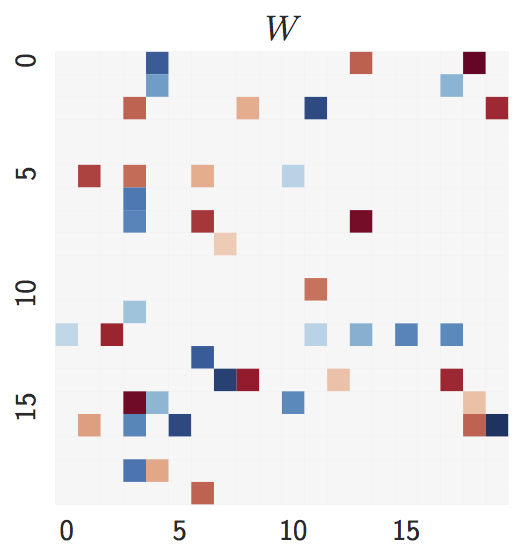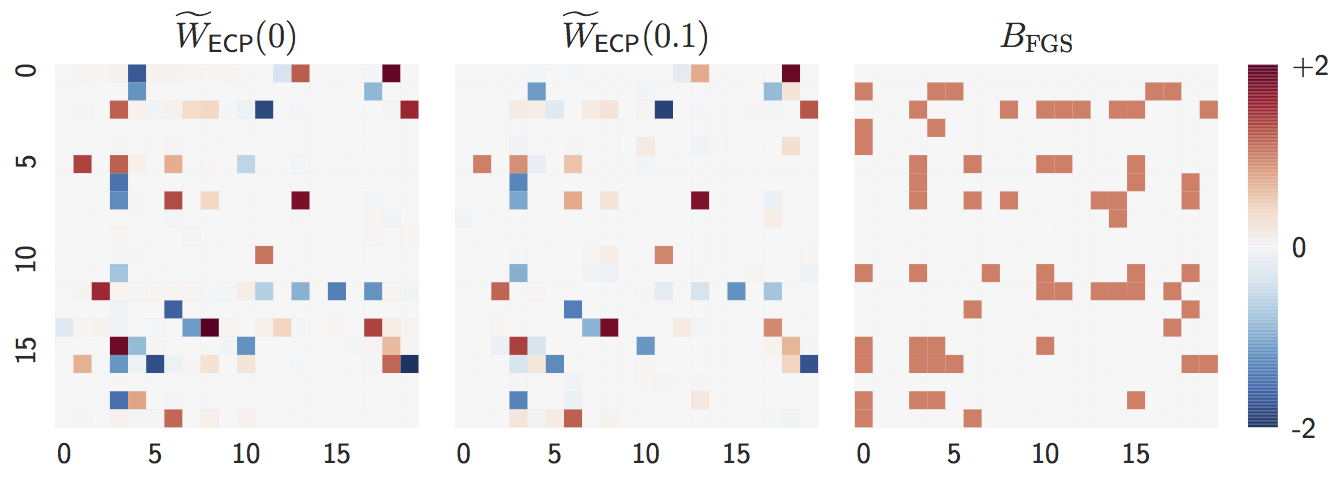This is an implementation of the following paper:
DAGs with NO TEARS: Continuous Optimization for Structure Learning (NIPS 2018, Spotlight)
Xun Zheng, Bryon Aragam, Pradeep Ravikumar, Eric Xing.
If you find it useful, please consider citing:
@inproceedings{zheng2018dags,
author = {Zheng, Xun and Aragam, Bryon and Ravikumar, Pradeep and Xing, Eric P.},
booktitle = {Advances in Neural Information Processing Systems {(NIPS)}},
title = {{DAGs with NO TEARS: Continuous Optimization for Structure Learning}},
year = {2018}
}
Check out simple_demo.py for a complete, end-to-end implementation of the NOTEARS algorithm in fewer than 50 lines.
A directed acyclic graphical model (aka Bayesian network) with d nodes defines a
distribution of random vector of size d.
We are interested in the Bayesian Network Structure Learning (BNSL) problem:
given n samples from such distribution, how to estimate the graph G?
A major challenge of BNSL is enforcing the directed acyclic graph (DAG) constraint, which is combinatorial. While existing approaches rely on local heuristics, we introduce a fundamentally different strategy: we formulate it as a purely continuous optimization problem over real matrices that avoids this combinatorial constraint entirely. In other words,
where h is a smooth function whose level set exactly characterizes the
space of DAGs.
- Python 3.5+
- (optional) C++11 compiler
- Simple NOTEARS (without l1 regularization)
simple_demo.py- the 50-line implementation of simple NOTEARSutils.py- graph simulation, data simulation, and accuracy evaluation
- Full NOTEARS (with l1 regularization)
cppext/- C++ implementation of ProxQNnotears.py- the full NOTEARS with live progress monitoringlive_demo.ipynb- jupyter notebook for live demo
The simplest way to try out NOTEARS is to run the toy demo:
git clone https://github.com/xunzheng/notears.git
cd notears/
pip install -r requirements.txt
python simple_demo.py
This runs the 50-line version of NOTEARS without l1-regularization on a randomly generated 10-node Erdos-Renyi graph. Since the problem size is small, it will only take a few seconds.
You should see output like this:
I1026 02:19:54.995781 87863 simple_demo.py:77] Graph: 10 node, avg degree 4, erdos-renyi graph
I1026 02:19:54.995896 87863 simple_demo.py:78] Data: 1000 samples, linear-gauss SEM
I1026 02:19:54.995944 87863 simple_demo.py:81] Simulating graph ...
I1026 02:19:54.996556 87863 simple_demo.py:83] Simulating graph ... Done
I1026 02:19:54.996608 87863 simple_demo.py:86] Simulating data ...
I1026 02:19:54.997485 87863 simple_demo.py:88] Simulating data ... Done
I1026 02:19:54.997534 87863 simple_demo.py:91] Solving equality constrained problem ...
I1026 02:20:00.791475 87863 simple_demo.py:94] Solving equality constrained problem ... Done
I1026 02:20:00.791845 87863 simple_demo.py:99] Accuracy: fdr 0.000000, tpr 1.000000, fpr 0.000000, shd 0, nnz 17
The Proximal Quasi-Newton algorithm is at the core of the full NOTEARS with
l1-regularization.
Hence for efficiency concerns it is implemented in a C++ module cppext
using Eigen.
To install cppext, download Eigen submodule and compile the extension:
git submodule update --init --recursive
cd cppext/
python setup.py install
cd ..
The code comes with a Jupyter notebook that runs a live demo. This allows you to monitor the progress as the algorithm runs. Type
jupyter notebook
and click open live_demo.ipynb in
the browser.
Select Kernel --> Restart & Run All.
(TODO: gif)
-
Ground truth:
d = 20nodes,2d = 40expected edges.
-
Estimate with
n = 1000samples:lambda = 0,lambda = 0.1, andFGS(baseline).
Both
lambda = 0andlambda = 0.1are close to the ground truth graph whennis large. -
Estimate with
n = 20samples:lambda = 0,lambda = 0.1, andFGS(baseline).
When
nis small,lambda = 0perform worse whilelambda = 0.1remains accurate, showing the advantage of L1-regularization.
-
Ground truth:
d = 20nodes,4d = 80expected edges.
The degree distribution is significantly different from the Erdos-Renyi graph. One nice property of our method is that it is agnostic about the graph structure.
-
Estimate with
n = 1000samples:lambda = 0,lambda = 0.1, andFGS(baseline).
The observation is similar to Erdos-Renyi graph: both
lambda = 0andlambda = 0.1accurately estimates the ground truth whennis large. -
Estimate with
n = 20samples:lambda = 0,lambda = 0.1, andFGS(baseline).
Similarly,
lambda = 0suffers from smallnwhilelambda = 0.1remains accurate, showing the advantage of L1-regularization.
